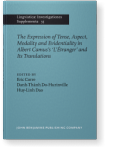Chapter 18
Traduire les discordances temporelles dans
L’Étranger
In L’Étranger, Camus not only
uses the passé composé instead of the passé
simple throughout his story, but he often unexpectedly
combines the different tenses of the French verbal system; for
example, by using a passé composé when one expects
an imparfait (or vice versa); or by using a
présent, when one expects an
imparfait. In this article, I will examine the
extent to which these temporal dissonances are reflected in the last
three translations of Camus’ novel into English. The retrospective
examination of L’Étranger through the prism of
these three translations (Laredo, 1982 ; Ward,
1988 ; Smith,
2012) will allow us to shed new light on the combinations
of verbal forms that make this novel so unique in terms of
style.
Article outline
- 1.Introduction
- Histoire vs discours – passé simple vs passé composé
- Imparfait
- Les traductions en anglais
- 2.Alternance présent / imparfait
- 3.Passés composés discordants
- 4.Imparfait et instabilité des repérages
- Conclusion
-
Remarques
-
Références
Article language: French
